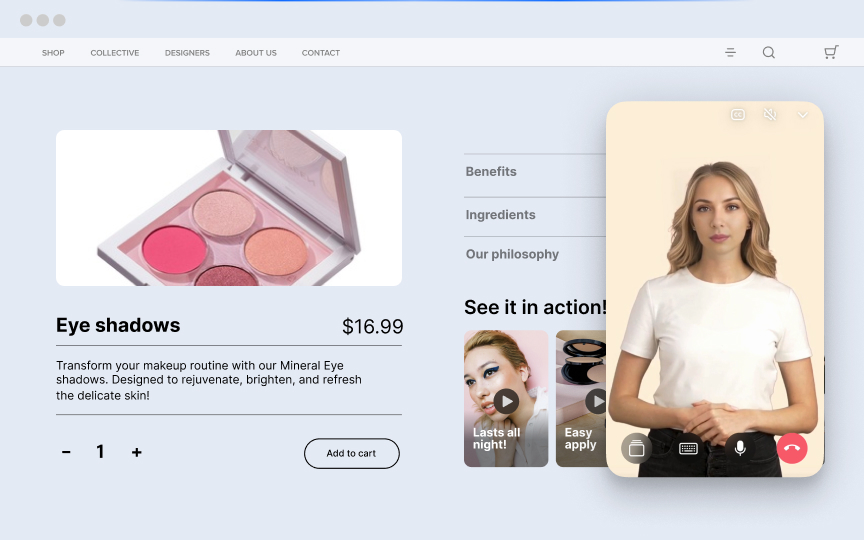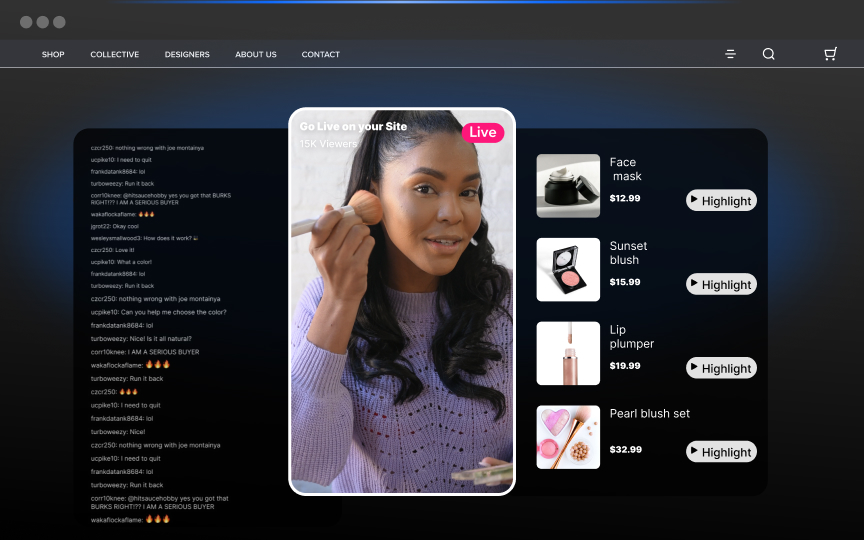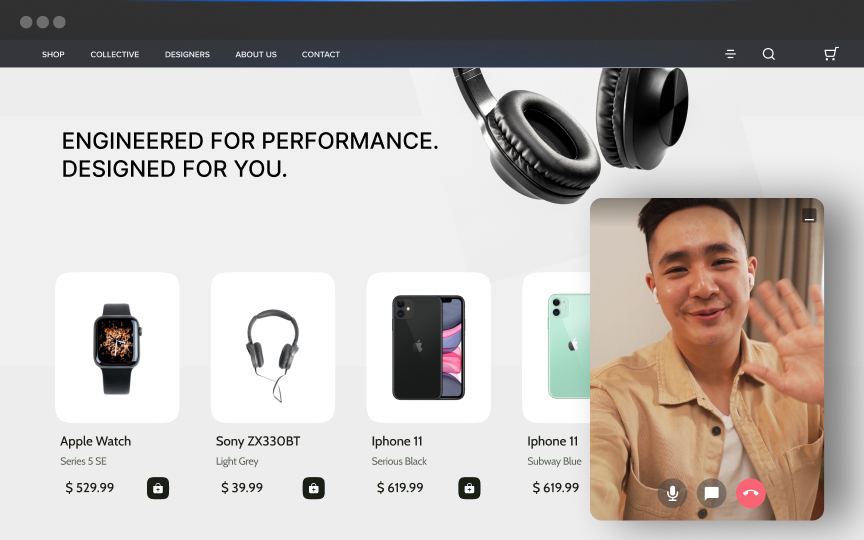11 Ways to Blend Your Online & In-store Experience Today
The global pandemic in 2020 caused a significant shift in commerce and wholly altered the buying experiences. Strict lockdowns made it difficult for consumers to shop in physical stores, leading to increased online sales. As a result, more than 12,000 physical stores, including Sears and Macy's, were slated for closure. Physical businesses will continue to be necessary for the fast access to items and services they provide, but many consumers who have tried online shopping won’t prefer going to a store.Most businesses have had to adjust to these shifting consumer preferences by prioritizing digital marketing methods and, in doing so, aligning online and in-store experiences tops their list.
What is an In-Store Experience?
To keep up with their online counterparts, stores are moving towards becoming experience centers rather than just brick-and-mortar outlets. In-store experiences are now encompassing a tactile, memorable sensory experience that draws customers to the brand as a whole. It goes beyond selling just one product or product range and seeks to create a personalized, holistic buying experience for the customer. Understandably, brands are trying to balance having a digital presence and maintaining constant foot traffic. To improve customer experience in-store, Tiffany and Co. recently included jewelry personalization options and a perfume vending machine in their London Covent Garden outlet. Made.com attached QR codes on their products to find and purchase online. Beauty brand Sephora enabled virtual try-on and rewards points to blend their in-store and online shopping experiences perfectly. And most brands are seeing results through sales, social media conversations and conversions.
How Important Is It To Provide An Innovative In-store Experience?
The COVID-19 lockdown relaxations in 2021 saved the world from a retail apocalypse, with retail commerce sales bouncing back. Retailers providing an in-store experience that’s out of the ordinary tend to get more attention and grow faster.
In 2021, 90% of shoppers said they would return to stores if they had a positive experience. Good in-store experiences can help build customer loyalty and a better brand image.
Instead of standardization, the best in-store experiences have intricate personalization layered with immersive activities. Today, we see brands experimenting and creating various experiences with innovative self-service, click-and-collect options and brand-building activities. However, a good starting point is understanding the basics of building engaging in-store retail experiences.
How To Create And Improve Customer Experience In-Store?
We have entered a ‘retailtainment’ era, where retail and entertainment must go hand-in-hand to create exclusive shopping experiences. The growing competition in the retail industry is fierce as shoppers have multiple options available. Between eCommerce and subscription models, retailers need to create compelling reasons for shoppers to keep coming back. Let’s see how brands can do this:
1. Be a friendly expert, not a sales-y consultant
Instead of jumping into technology and physical in-store experiences, creating the right environment for shopping is essential. This includes how the salespeople in your store greet and interact with customers. Educating and training your store staff about policies and products is the bare minimum nowadays. Brands like Lush set competitive standards for in-store experiences by training their staff to be friendly associates. Lush tries to train its staff to recognize different types of shoppers and personalize interactions with them accordingly. They also vouch for associates to go ‘off-script’ in dealing with customers or offer free product samples, all in an effort to offer memorable in-store service.

Source: Along with well-trained associates, Lush stores are also known for their unique and interactive layout.
Your team goes wrong the moment they try to sell a product to the customer’s face. It hinders the connection that needs to be established and might even frustrate the customer. Hence, ensure that you hire and train a team of friendly experts to improve customer experience in-store.
2. Align your online and in-store experience with livestream
If you have an eCommerce store and a physical one, ensure they work together.
A 2019 study shows that 81% of shoppers go online before visiting a store. If they find a disconnect between these two experiences, they lose trust in the brand.
So how can a brand maintain the needed alignment? There are several ways to do so, such as click-and-collect (people buy online and collect the product from the physical store) or creating a website in-store experience (where shoppers can browse the website even in the store). Brands can also:
i. Replicate the presence of a sales assistant online
With methods like livestreaming, customers can interact with the brand representative, ask questions and explore the product in real-time, just like a physical store.
ii. Translate in-store level of personalization
As livestream caters to customer queries in real time and provides them with instant checkout options, brands can create personalized experiences. They can also leverage post-livestream analytics to communicate and offer discounts based on individual buying patterns.
iii. Make online customer service as easily accessible as in-store services
Besides chatbots and AI tools, brands can use livestreaming to leverage face-to-face interactions, a proven method of establishing a connection with the customer. With these options, livestreaming has proven to be one of the most effective methods for aligning physical and online stores.
Firework partnered with Walmart Connect to launch a live shopping experience in support of Walmart’s Mega Beauty Event with brands J&J, L’Oreal, P&G, and Unilever. The event includes four livestreams, features replays and shoppable videos for continued engagement.
This shows we cannot exclude any sector, including the grocery sector, from leveraging digital elements in harmony with their physical stores.
Source: Embrace the future of retail with Firework’s livestream shopping services
3. Offer self-service using digital signage
https://youtu.be/viXbDDGueqo
Source: Decathalon makes self-service innovative with RFID Tills
To capitalize on the growing acceptance of self-service in retail shopping, Decathlon is utilizing interactive digital signs. The online shopping functionality is available in large in-store displays, allowing shoppers to browse products, add them to carts, and finish their purchases. While customers shop, try on sports gear or run errands, the store personnel can pack and deliver the items.Self-service kiosks and digital stops in stores can help relieve bottlenecks like long checkout lines. People comfortable with digital interactions can get their orders faster. After placing the order, the customer is free to browse the store again.
4. Provide immersive AR in-store experience
Immersive Augmented Reality (AR) is at the forefront of retailtainment. Such experiences can vary from an interactive digital display to AI-assisted trial rooms. AR experiences bring the best of physical and digital shopping and create a unique in-store customer experience for customers.

Source: Farfetch earned the ‘Retailer of the Future’ title by offering immersive in-store experiences
Farfetch, for example, combines technology and fashion to make customer experiences more human. They offered connected clothes racks, touch-screen-enhanced mirrors, and sign-in kiosks in its London store that gathered online information to use in-store. Customers could log in to Farfetch to search their purchase history and wish list, giving the sales assistants valuable client knowledge. A smart mirror could be used to order alternate sizes and alternative products or to make a payment without leaving the dressing room. Such innovations earned them the label ‘The Retailer of the Future.’
5. Build communities, not stores
In June, Apple dropped the word ‘Store’ from all the Apple Stores. “Apple Store, Valley Fair” is now simply “Apple Valley Fair.” The changed apple in-store experience was crafted to exempt customers from thinking of these locations as ‘retail outlets’. Instead, Apple is now going for a ‘Town Square Experience,’ where they want customers to come together as a community. Their new-generation stores are installed with boardrooms for entrepreneurs to discuss ideas and even hour-long coding classes. Apple also incorporated ‘Teacher Tuesdays’ in their stores to help teachers leverage technology in their classrooms.

Source: Apple’s next-gen Union Square retail store aims at community-building
Brands can take a page from the innovative apple in-store experience to create communities. Livestream shopping is another way to build communities online, as customers interact with one another through comments and meet like-minded individuals. Communities can spread brand awareness, attract new leads, generate sales and build brand loyalty.
6. Offer experience zones for trials
The 30,000 square feet of House of Vans in London bring fashion, art, music, BMX, and street culture under one roof. In addition, there are ramps, a street course, and live music. This is the best way to create a ‘Vans experience,’ which reflects just what the brand stands for.

Source: Experiential shopping at House of Vans, London
Experiential shopping is a great way to build your brand while giving customers an interactive way to shop. Such stores go beyond selling a product and ensure an emotional connection with the customers. This experiential appeal can help keep customers coming back for more.Along with these experiential tips, you can make dedicated efforts to promote a product in-store. Best in-store experiences utilize the physical store by adding layers of digital innovation. Some great ways to do this include:
7. Window Displays
Window displays are often the first step of in-store experiences. Thus, simply plopping a mannequin won’t drive customers into the store. Rather, the window display should be a powerful way to differentiate your brand. It can be done by creating a story and understanding your target audience. You can get as innovative as you want. Many brands try to focus on selling a lifestyle rather than a product. Isabel Marant, for example, is a French fashion house whose store display creates romantic moments to draw customer attention. It is a hit because of the desire it drives by emoting love through the pictures and its products.https://www.pinterest.com/pin/539939442811515469/
Fig: Window Display of Isabel Marant
8. Educating customers converts them into your brand ambassadors
Who better than a happy customer to promote your brand? When you sell with the strategy of converting customers into your ambassadors, you must be able to address their needs. This includes having energetic salespeople to assist them, immersive technologies that create product awareness, and constantly using their feedback to improve. You can also offer referrals and special offers to elevate the in-store customer experience, which they can happily boast about to their near ones.
9. In-store events and brand collaborations
Customers vouch for two brands to come together and create fun in-store experiences. Brand collaborations vary from similar brands coming together to offer an advanced product, like Adidas and All Birds' sustainable shoes, to having small in-store kiosks or counters of a brand. Such collaborations drive loyal customers from both brands. In fact, partnerships can be improved with in-store events. Consider Sephora, which partnered with Dr. Dennis Gross, a renowned dermatologist. Sephora created a ‘Peel Mobile’ where Dr. Gross gave consultations and performed the exclusive peel, which could only be availed in his office. They also came up with offers like free goodies for $150 on DG products. This resulted in a noticeable footfall and increased sales for DG products.

Source: The collaboration between Sephora and Dr. Dennis Gross led to high sales and increased footfall
10. Discounts
Discounts have been creating the best in-store experiences for as long as we can remember. Strategically planned and creatively communicated deals can generate enough excitement to increase foot traffic. Additionally, offering discounts based on memberships and premium subscriptions gives the customer the ‘special’ feeling of being preferred over others. With a few simple steps, you can bring your customers closer to the brand and offer an in-store experience of convenience and delight.
Pro tip:
To reach the maximum potential for in-store experiences, ensure a balance between advertising, branding and a good store experience. While in-store advertising can range from showcasing your best product or products that complement your brand, in-store branding focuses on blending elements of your brand identity into the store. For example, it can range from colors or a prominent logo that can enable brand recall. The store ambiance is, however, more experiential. It creates sensory experiences that consumers take back with them, wanting more in the future. By taking the right measures you can create a truly memorable feeling for your customers.
Wrap Up
Physical stores might never entirely go out of fashion, but digital commerce is accelerating. Brands can adapt by providing what consumers want right where they are. This includes creating an omnichannel in-store customer experience to develop their brand sustainably, increase customer loyalty, and stay ahead of the curve. Live Commerce simply translates the essential component of in-person shopping—the human connection—to the online world.









